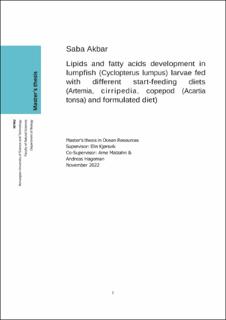| dc.contributor.advisor | Kjørsvik, Elin | |
| dc.contributor.advisor | Malzahn, Arne | |
| dc.contributor.advisor | Hagemann, Andreas | |
| dc.contributor.author | Akbar, Saba | |
| dc.date.accessioned | 2022-12-24T18:19:34Z | |
| dc.date.available | 2022-12-24T18:19:34Z | |
| dc.date.issued | 2022 | |
| dc.identifier | no.ntnu:inspera:119036896:47161089 | |
| dc.identifier.uri | https://hdl.handle.net/11250/3039477 | |
| dc.description.abstract | | |
| dc.description.abstract | Salmon lice (Lepeophtheirus salmonis) infestations on Salmonids (Salmo salar) in cages has brought Norwegian aquaculture to a stable production since 2012. Many chemotherapeutic , chemical, and mechanical approaches have been used to control the sea lice attack. Unfortunately, sea lice have developed resistance against chemotherapeutic treatments and other approaches are either not considered ecofriendly or effect fish health. Biological control is deploying cleaner fish in cages to combat the sea lice. Lumpfish (Cyclopterus lumpus) is of commercial interest as a cleaner fish since it can be deployed at age of 4 months. The complicated first feeding phase and a lack of functional feeding protocols are the major barriers to large-scale lumpfish cultivation.
The current study aimed to contribute to the optimization of start-feeding regimes for lumpfish larvae in commercial farming. This was accomplished by comparing the effects of various start-feeding diets on the growth and survival of fish larvae. In addition to this development of lipids and fatty acids in lumpsucker larvae in relation to different feeding regimes was studied. Five feeding regimes were used in the experiment where lumpsucker larvae were fed from 2days post hatch to 35 dph. One group of larvae were fed with enriched artemia which were then weaned to formulated diet (FD). Second group were initially fed with copepods and then ultimately weaned to FD. Third group had Cirripedia initially and then weaned to FD. Fourth group had three types of feed initially copepods , then Cirripedia and then FD. Fifth group were fed with formulated diet firstly with small pellets(150nm) and then with large pellets (300nm).
Larvae fed with Artemia had best growth and survival as compared to other feeding regimes. Total lipid content and fatty acid content was highest in Art larvae initially and decreased on weaning to formulated diet but still significant. Artemia had significant amount of omega 3 and omega 6 fatty acids contributing to good growth and survival. Until 35 dph lipid content went steady in Art larvae. Lipidomics revealed that several lipid and fatty acid species are correlated either negatively or positively. The results clearly show the importance and responses of certain fatty acids in starting feed and can be helpful in optimizing start-feed of lumpsucker larvae. | |
| dc.language | eng | |
| dc.publisher | NTNU | |
| dc.title | Lipids and fatty acids development in lumpfish (Cyclopterus lumpus) larvae fed with different start feeding diets (Artemia, cirripedia, copepod (Acartia tonsa) and formulated diet | |
| dc.type | Master thesis | |
